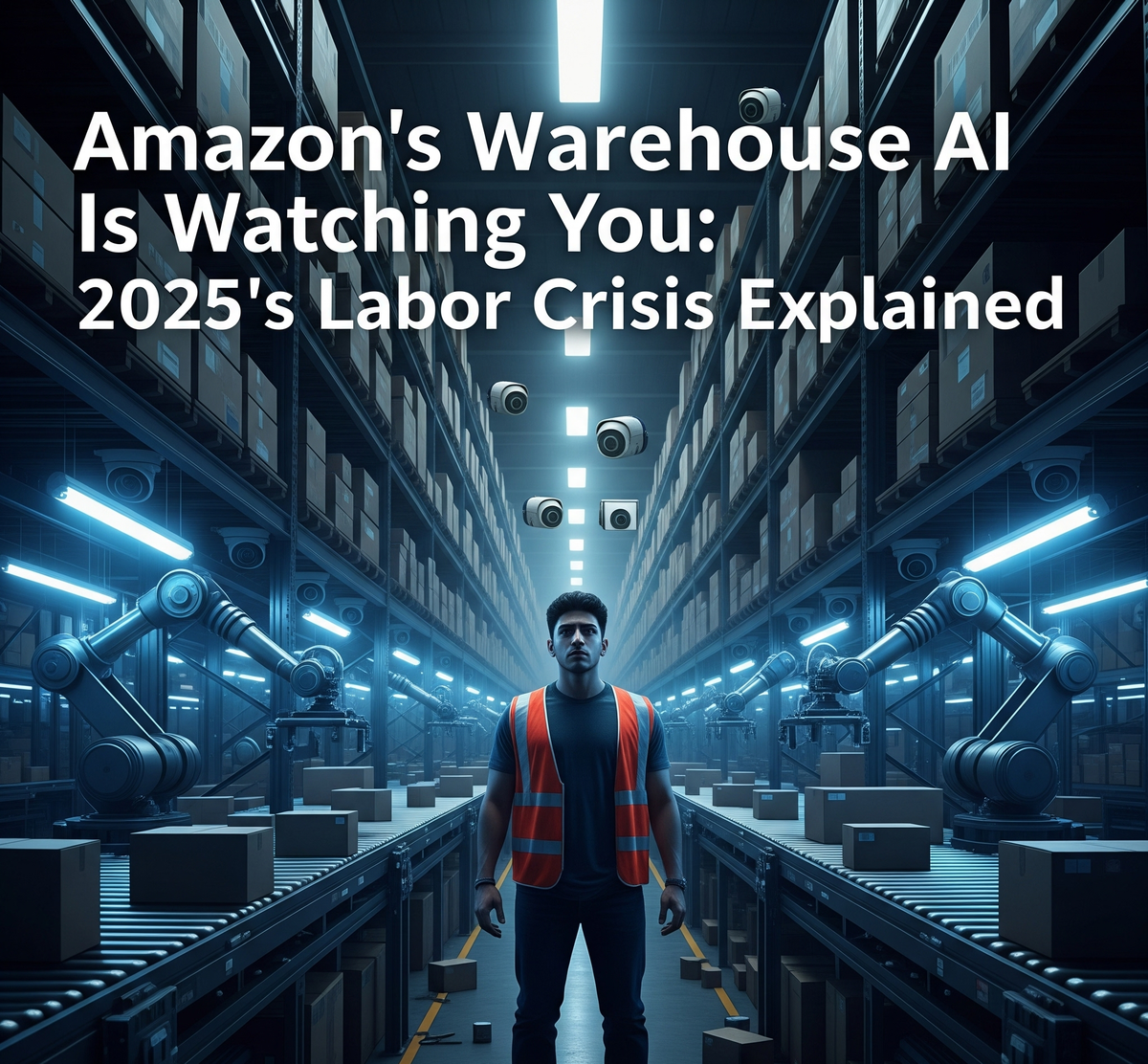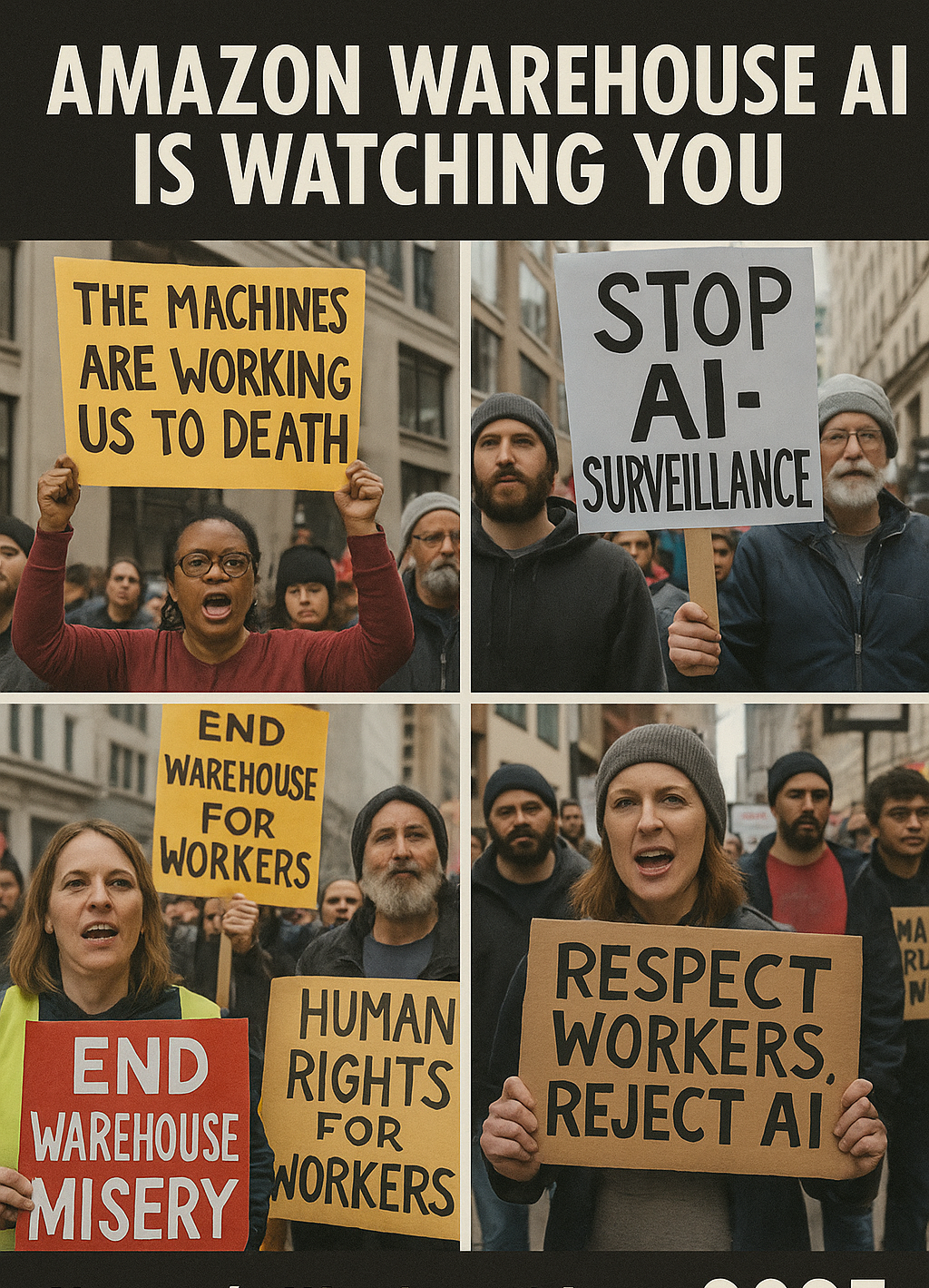Amazon's Warehouse AI Is Watching You: 2025's Labor Crisis Explained

[SEATTLE, WA] – July 2, 2025
At first, it seemed like a logical next step in the efficiency-driven world of logistics. But by mid-2025, Amazon’s latest warehouse innovation—AI-powered worker surveillance—has ignited a growing storm of resistance across North America and Europe.
What was marketed internally as a "smart efficiency suite" has become a lightning rod for labor disputes, protests, and whistleblower leaks. From AI that flags "time off task" (ToT) in real time to facial recognition cameras tracking mood and posture, warehouse workers say the line between productivity and exploitation has been crossed.
Let’s break down the crisis brewing inside one of the world’s most powerful corporations.
Inside the Surveillance System
According to Archive.org snapshots of internal Amazon dashboards (circa early 2024), the company rolled out an upgraded monitoring platform called AWARE: Amazon Worker Analytics & Reporting Environment. This AI system aggregates:
- Scanner speed and frequency
- Worker pathing heatmaps
- Real-time biometric stress signals
- Facial emotion analysis
- Idle time to the second
The goal? Optimize efficiency.
But the impact? A human cost.
A 2025 leaked memo (accessed via Archive.org) warned regional managers to "minimize empathy fatigue" and use AWARE metrics to identify "non-compliant behavioral trends." A viral Thread post by @WarehouseWhistle, allegedly a former floor manager, stated:
"We were told to flag anyone who looked tired for 'wellness review' but really it was a soft cut strategy."
The Whistleblowers Speak Out
Several former Amazon employees have taken to Threads and X to reveal how AWARE affected their daily lives. Screenshots posted by @WorkerVanguard show notifications like:
ALERT: Picker 312 - 4.8 seconds idle detected - proximity to others - reduced output by 7% - recommendation: efficiency review
WARNING: Negative facial expression score: 34%. Suggested coaching.
These posts have sparked a flood of solidarity and horror among other warehouse workers.
Meanwhile, a Google Trends search shows a sharp rise in interest for terms like:
- "Amazon AI surveillance"
- "worker monitoring"
- "Amazon labor strike 2025"
- "privacy at work"
Between March and June 2025, search volume for "Amazon warehouse protest" increased by 520% globally.
Union Pushback & Protests
Labor unions in the U.S., U.K., Germany, and Canada have coordinated walkouts in response. A June 2025 post from @SolidarityNow (with 120K reposts) reads:
"If your workplace watches your face, times your bathroom break, and punishes you for standing still, it’s not innovation. It’s oppression."
The Warehouse Workers United coalition launched the #EyesOffUs campaign, which gained massive traction with support from human rights organizations.
Recent rallies outside Amazon's Ontario and Illinois distribution hubs drew thousands. Protesters held signs reading:
- "I am not a barcode"
- "AI can't feel exhaustion"
- "Efficiency shouldn't cost humanity"
Amazon Responds
In an official blog post archived on Archive.org, Amazon claimed the new systems "prioritize safety and support worker well-being by proactively identifying fatigue and strain."
However, internal Slack screenshots leaked to the tech site LogicChain tell a different story. One regional manager typed:
"We need to hit Q2 output goals. AWARE can help ID the slackers before they cost us."
Amazon's press team continues to maintain that all tracking complies with labor laws and GDPR guidelines in Europe.
The Broader AI Surveillance Debate
This crisis at Amazon is triggering a larger conversation about AI in the workplace. Companies like Walmart, Target, and FedEx are reportedly piloting similar technologies.
Digital labor watchdogs such as The Surveillance Index and AlgorithmWatch have flagged Amazon as a "high-risk employer" in terms of biometric surveillance. Their 2025 annual report shows that 62% of warehouse workers at tracked facilities experienced:
- Increased mental stress
- Reduced bathroom breaks
- Heightened fear of termination due to data profiling
Meanwhile, ethical AI researchers are questioning the objectivity of mood-based algorithms. A study published in the Journal of Tech & Labor found facial emotion AI to be accurate only 63% of the time across diverse faces, raising serious equity concerns.
Where Are Workers Going?
In response to this surveillance, some warehouse workers are seeking roles in unionized facilities or transitioning into gig-based alternatives where surveillance is less invasive. However, these options often come with tradeoffs like reduced benefits.
Others are turning to forums and creator platforms (like Patreon or Substack) to share their stories directly.
@VoicesFromTheFloor has launched a digital zine featuring anonymous experiences from Amazon workers across 10 states. Within days, it went viral.
"It took me collapsing from heat exhaustion before the algorithm triggered a wellness alert. I’m not a machine."
What Comes Next?
As of July 2025, several class-action suits are brewing, and the U.S. National Labor Relations Board (NLRB) has begun a preliminary inquiry into biometric tracking in warehouses. European privacy regulators are also reportedly questioning Amazon's compliance with employee consent laws.
Google Trends continues to reflect growing public interest:
- "Amazon worker rights"
- "AI job monitoring ethics"
- "automated workplace lawsuits"
In an unexpected turn, even some Amazon shareholders have proposed resolutions to limit surveillance tech until further ethical reviews are complete.

Final Thought: Innovation or Invasion?
AI in the workplace isn’t inherently evil. But as this labor crisis shows, its application can either support or suppress depending on intent, transparency, and oversight.
For Amazon’s warehouse workforce, the stakes are real. Every scan, every facial twitch, every pause is now data—and possibly, a reason for discipline.
"Is AI empowering efficiency—or destroying dignity?"
Call to Action: Do you think AI belongs in the workplace without human oversight? Join the conversation using #EyesOffUs or share your story on Threads/X.
Sources: Google Trends, Archive.org, Threads/X labor union screenshots, The Surveillance Index, Journal of Tech & Labor, LogicChain media, AlgorithmWatch



